
Portuguese is a Western Romance language of the Indo-European language family originating from the Iberian Peninsula of Europe. It is the official language of Angola, Brazil, Cape Verde, Guinea-Bissau, Mozambique, Portugal and São Tomé and Príncipe, and has co-official language status in East Timor, Equatorial Guinea and Macau. Portuguese-speaking people or nations are known as Lusophone. As the result of expansion during colonial times, a cultural presence of Portuguese speakers is also found around the world. Portuguese is part of the Ibero-Romance group that evolved from several dialects of Vulgar Latin in the medieval Kingdom of Galicia and the County of Portugal, and has kept some Celtic phonology.

Tetum is an Austronesian language spoken on the island of Timor. It is one of the official languages of Timor-Leste and it is also spoken in Belu Regency and in Indonesian West Timor.

The Lombard language belongs to the Gallo-Italic group within the Romance languages. It is characterized by a Celtic linguistic substratum and a Lombardic linguistic superstratum and is a cluster of homogeneous dialects that are spoken by millions of speakers in Northern Italy and southern Switzerland. These include most of Lombardy and some areas of the neighbouring regions, notably the far eastern side of Piedmont and the extreme western side of Trentino, and in Switzerland in the cantons of Ticino and Graubünden. The language is also spoken in Santa Catarina in Brazil by Lombard immigrants from the Province of Bergamo, in Italy.

The languages of East Timor include both Austronesian and Papuan languages. The lingua franca and national language of East Timor is Tetum, an Austronesian language influenced by Portuguese, with which it has equal status as an official language. The language of the Oecusse exclave is Uab Meto (Dawan). Fataluku is a Papuan language widely used in the eastern part of the country. A dialect of Malay-based creole called Dili Malay is spoken by a number of residents in the capital Dili, it borrowed words mostly from Portuguese and Tetum. Both Portuguese and Tetum have official recognition under the Constitution of East Timor, as do other indigenous languages, including: Bekais, Bunak, Galoli, Habun, Idalaka, Kawaimina, Kemak, Lovaia, Makalero, Makasae, Mambai, Tokodede and Wetarese.

In the linguistics of the Romance languages, the La Spezia–Rimini Line, also known as the Massa–Senigallia Line, is a line that demarcates a number of important isoglosses that distinguish Romance languages south and east of the line from Romance languages north and west of it. The line divides northern and central Italy, running approximately between the cities of La Spezia and Rimini. Romance languages south and east of it include Italian and the Eastern Romance languages, whereas Catalan, French, Occitan, Portuguese, Romansh, Spanish, and the Gallo‒Italic languages are representatives of the Western group. In this classification, the Sardinian language is not part of either Western or Eastern Romance.

Baucau is a municipality, and was formerly a district, of East Timor, on the northern coast in the eastern part of the country. The capital is also called Baucau. The population of the municipality is 111,694 and it has an area of 1,506 km2.
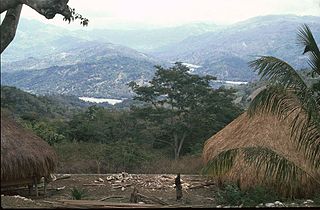
Bobonaro is a municipality in the Democratic Republic of Timor-Leste commonly known as East Timor. It is the second-most western municipality on the east half of the island. It has a population of 92,045 and an area of 1,376 km2.
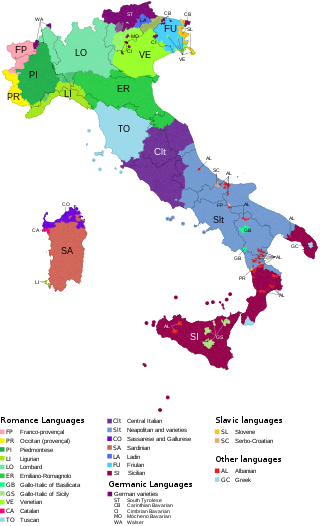
The languages of Italy include Italian, which serves as the country's national language, in its standard and regional forms, as well as numerous local and regional languages, most of which, like Italian, belong to the broader Romance group. The majority of languages often labeled as regional are distributed in a continuum across the regions' administrative boundaries, with speakers from one locale within a single region being typically aware of the features distinguishing their own variety from others spoken nearby.

The Gallo-Italic, Gallo-Italian, Gallo-Cisalpine or simply Cisalpine languages constitute the majority of the Romance languages of northern Italy: Piedmontese, Lombard, Emilian, Ligurian, and Romagnol. In central Italy they are spoken in the northern Marches ; in southern Italy in some language islands in Basilicata and Sicily.

The National University of East Timor, is a public university in East Timor, the only one of its kind in the country.

Lautém is one of the municipalities of East Timor, at the eastern end of the country. It has a population of 64,135 and an area of 1,813 km2. Its capital is Lospalos, which lies 248 km east of the national capital, Dili.

The Instituto Camões, formally, Camões — Instituto da Cooperação e da Língua, I. P., is a Portuguese international institution dedicated to the worldwide promotion of the Portuguese language, Portuguese culture, and international aid, on behalf of the Government of Portugal. Headquartered in Lisbon with centers across five continents, the mission of the Instituto Camões is the promotion of Portugal's language, culture, values, charity, and economy. The institution is named for Portuguese Renaissance author Luís Vaz de Camões, considered the greatest poet of the Portuguese language and the national poet of Portugal.
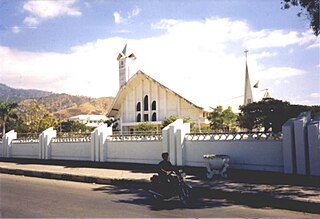
Dili Municipality is one of the 14 municipalities, formerly districts, of Timor-Leste, and includes the national capital Dili. The municipality had a population of 277,279 as of 2015, most of whom live in the capital city.
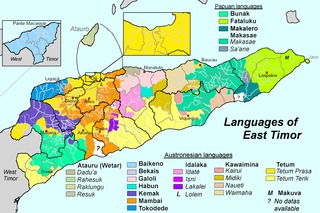
Atauran is an Austronesian language spoken on Atauro island and in Manatuto Municipality, East Timor. It is closely related to Wetarese and Galoli.

East Timorese Portuguese, or Nusantaran Portuguese, is the variety of the Portuguese language spoken in Timor-Leste. It is one of the official languages of Timor-Leste alongside Tetum. As with other Lusophone countries besides Brazil, the Portuguese language curriculum in East Timor is based on European Portuguese, with some localisations in pronunciation. East Timor is the only sovereign state in Asia with Portuguese as an official language. There is a growing demand for Portuguese-language courses in the country, both at early-learning and tertiary levels of education.
The Timoric languages are a group of Austronesian languages spoken on the islands of Timor, neighboring Wetar, and Southwest Maluku to the east.

Western Romance languages are one of the two subdivisions of a proposed subdivision of the Romance languages based on the La Spezia–Rimini Line. They include the Gallo-Romance, Occitano-Romance and Iberian Romance branches. Gallo-Italic may also be included. The subdivision is based mainly on the use of the "s" for pluralization, the weakening of some consonants and the pronunciation of "Soft C" as /t͡s/ rather than /t͡ʃ/ as in Italian and Romanian.
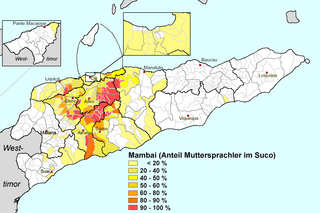
Mambai, also called Mambae or Manbae, is a language spoken by the Mambai people, the second largest ethnic group in the island country of East Timor.

Idalaka is a Malayo-Polynesian dialect chain spoken in East Timor. The name is a portmanteau of Idaté and Lakalai.
Matías Freitas Boavida is a politician and university teacher from East Timor. He is member of the party Fretilin.


















